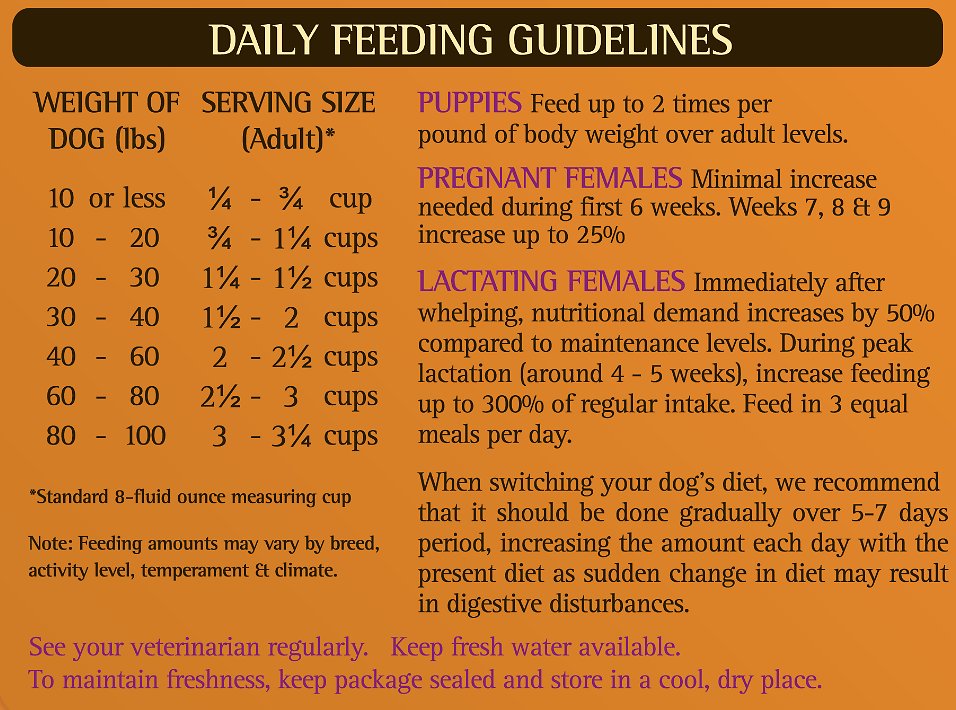If there is one thing I learned from hovering over the meal prep table on a holiday weekend, it’s that we need some education on feeding guidelines for our pets! We see everything from overfeeding to underfeeding to free feeding, and sometimes a side of chicken nuggets or broccoli and anything in between! Even mashed bananas and yogurt and pumpkin and cheese and AAAAH!! So many things! It doesn’t have to be that complicated, my friends!
We’ve put together a few tips based on years of prepping meals for doggies, and our experience at seeing which meal methods correspond to the healthiest, happiest furries.
Start with good food – it really doesn’t cost more. If you look at the price tag on a bag of high quality dog food compared directly with some grocery store lesser quality food, you’re going to assume like any logical person, that it’s going to cost more to feed your dog the high quality stuff. Believe it or not, most of the time that’s wrong. Poor quality foods produce more waste, so typically you have to end up feeding your dog more in order for him to feel satisfied. In choosing a higher quality food, feeding less can still give your dog all the nutrients, calories, and satisfaction he needs!
The feeding guideline on the bag of dog food shouldn’t be taken as the gospel. Dog food manufacturers tend to err on the side of caution and provide a WIDE range for what the consider an appropriate amount of food for the dog’s size. For example, my dogs all weigh roughly 25 pounds. For that weight, their bag of dog food recommends a range of 1 5/8 to 2 cups per day for adult dogs. Wowza. If I fed my dogs even the bottom end of that range they’d be so fat they couldn’t walk! Reality for us is one level cup a day (1/2 cup AM and PM). This keeps them on the heavier end of a normal, comfortable weight.
Treat calories count too! Let’s say you’ve got the kibble feeding part down and everything is going well, but you’re working on something like potty training or learning a new trick, and you’re using treats for rewarding good behavior. Remember to cut the kibble down a bit when treats are part of the daily diet. The range on the dog food bag doesn’t factor in any kind of outside treats when it tells you how much to feed (and again remember it’s going to err on the hefty side as it is). Choose treats like Chicken Crack that are lean and meat-based, but are still perceived as high value (meaning YUMMY) to your dog and can be broken up into small pieces.
Your dog should be HAPPY about mealtime! If, when you go to the doggie food bin each morning, your dog isn’t doing a bit of a happy dance about it being mealtime, you may want to make some adjustments. It may not mean that your food choice is bad, but your dog may just not be that HUNGRY because you’re feeding too much. A 4 year old, 30 pound dog does not need to eat 2+ cups per day unless he is running several miles a day every day to burn those calories. You want your dog to be a little hungry when it’s time to eat! If you’ve cut back to an appropriate portion size and your dog still has little interest, don’t be afraid to change it up and try other foods! Most of the high quality dog foods available today have multiple flavor options within the same line so that you can switch flavors without all that transition time.
Cut back in an Arkansas summer. Every year when the humidity hell sets in, we get a bunch of frantic calls from parents that are worried about their dog not eating enough. A lot of the time it’s honestly the weather. Dogs’ bodies know when it’s hot outside that they’re going to be doing less activity (it’s too miserable to do anything fun) and signal to their brain that they don’t need/want the extra calories to carry around. Wouldn’t it be nice if that happened for us humans!! My dogs do a level half cup at each feeding; in summer we cut that down about 10%.
 Example of feeding guidelines from Zignature Kangaroo Formula
Example of feeding guidelines from Zignature Kangaroo Formula
If you’re not sure how much to feed or even where to start, this calculator from Dog Food Advisor might be helpful. Click here to try it! You can always ask your friendly neighborhood HH pack leader too…we make hundreds of meals each week and get a pretty good idea of what works and what doesn’t! We always recommend feeding a little heavy when your dog is coming in for boarding as well – the increased activity and calorie burn usually leads to a bigger appetite!
A bit of fine print for you – the tips above are based on an average adult dog. For puppies and seniors there could be quite a bit of variation based on their activity level. As an example, it is not uncommon for my senior dog Gunner to skip a meal or two a week during the summer. He mostly lays around and when it’s hot, even more so, so he just isn’t that hungry. If he skips a meal one morning I’ll give him a treat or two just so he doesn’t have an empty stomach and then we’re on our way. For puppy parents, the summer appetite shift may not happen, and puppies will need to be fed more based on how much they are growing at different stages. Your best bet is to talk to your vet about those more complex feeding needs.
Feel free to share your feeding experiences and what works best for your family, and we’re always here to help answer questions! Email me – [email protected]!
Lacey


